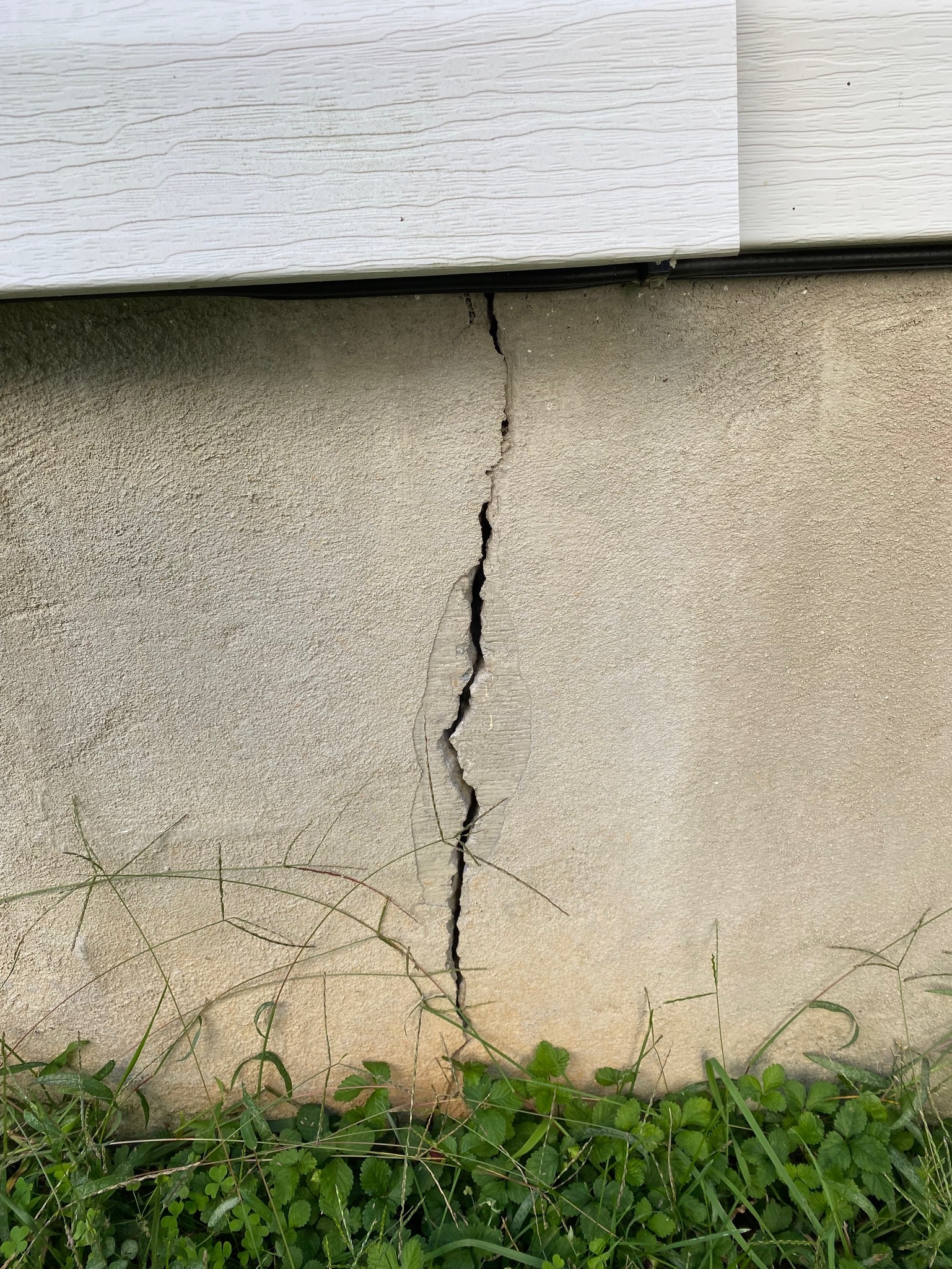
You’ve noticed cracks in your foundation and you’re searching for a quick, safe solution. Consider epoxy injections, a method that not only seals those troublesome cracks but reinforces the damaged area too. But how does it work? And why is it a more efficient option compared to traditional concrete repairs? We’ll explore these questions, revealing the science behind epoxy and why its thermosetting properties make it a reliable choice for long-term, hassle-free maintenance.
Key Takeaways
- Epoxy injection fills foundation cracks with a durable resin, resulting in quick, effective repair.
- The epoxy bonds stronger than concrete, preventing future cracking and enhancing structural integrity.
- Application of epoxy, even in wet conditions, is versatile and effective for both small and large cracks.
- Safety measures include using personal protective equipment and working in well-ventilated areas to prevent harmful fume exposure.
- Case studies show epoxy injection as a cost-effective, non-invasive, and fast solution for various foundation crack situations.
Understanding Foundation Cracks
Every homeowner fears the sight of foundation cracks. They’re not just unsightly; they could signal serious structural issues. To fully understand these miscreants, you need to explore crack causes and crack types.
Crack causes often originate from soil-related issues. If the soil beneath your home wasn’t compacted properly during construction, it might compress under the weight of your home, leading to settlement cracks.
Too much water in the soil can also cause upheaval cracks as the ground swells and pushes the foundation upward. Drought-like conditions could cause soil contraction, leading to differential settlement cracks.
As for crack types, you’ve got vertical, diagonal, and horizontal. Vertical cracks are often the least severe and are usually due to settlement.
Diagonal cracks can indicate differential settlement, where one part of your home is sinking faster than another. Horizontal cracks are the most serious, often caused by soil pressure.
Understanding crack causes and types is essential. It helps you assess the severity of the situation and decide on the most effective solution.
What Is Epoxy Injection?
Cracks in your foundation can be a homeowner’s nightmare, but epoxy injection might be the solution you need. This process involves filling the cracks with epoxy, a type of resin known for its durability and strength. There are different epoxy types and each has its unique characteristics and uses.
Epoxy injection involves a few steps. First, the crack is cleaned and prepared. Then, epoxy is injected directly into the crack. The application techniques vary depending on the type of epoxy and the nature of the crack, but the goal is always to fully fill the crack for a durable, long-lasting repair.
Here’s a quick look at how different epoxy types and application techniques can affect your repair:
| Epoxy Types | Application Techniques |
|---|---|
| Low-Viscosity | Injected with a caulking gun |
| Thixotropic | Applied with a trowel |
| Flexibilized | Injected with a specialized pump |
Epoxy injections are a safe, fast, and reliable way to fix foundation cracks. They can keep your home standing strong for years to come, potentially saving you a lot of stress and money in the long run.
The Science Behind Epoxy
Understanding the science behind epoxy can help you appreciate why it’s such an effective solution for foundation cracks. Epoxy is a result of resin chemistry, involving a reaction between epoxide resin and polyamine hardener. This process, called curing, creates a strong bonding material with unique epoxy properties.
When you inject epoxy into a foundation crack, you’re introducing this powerful bonding agent into a vulnerable area. The epoxy resin seeps into the smallest crevices, bonding with the concrete to form a solid, durable barrier. Thanks to resin chemistry, the cured epoxy possesses a remarkable ability to withstand pressure and resist degradation, providing long-lasting protection for your foundation.
The science of epoxy doesn’t end there. It’s also thermosetting, which means it doesn’t soften or melt under heat. Once epoxy cures, it maintains its strength and shape, even in extreme conditions. This makes it particularly suited to foundation repair, where it can face a range of environmental challenges.
Benefits of Epoxy Injections
You might be wondering why epoxy injections are a popular choice for fixing foundation cracks.
Well, the benefits are twofold: they not only enhance the structural integrity of your building, but they’re also a cost-effective solution.
Let’s explore how these advantages can save your property and your pocket.
Enhanced Structural Integrity
In an overwhelming majority of cases, epoxy injections greatly enhance the structural integrity of your foundation. This method not only fills up the existing cracks, but it also reinforces the foundation, providing it with additional strength.
When you opt for epoxy injections, you’re fundamentally investing in the future stability of your foundation. Here’s how it works: the epoxy forms a bond stronger than the concrete itself, making your foundation more resistant to future cracking and degradation.
This structural reinforcement guarantees that your foundation can bear the loads it was designed for, without the risk of further damage.
But there’s more. Given its exceptional bonding capabilities, epoxy also improves the foundation’s ability to withstand external pressures, such as soil movement and changes in temperature.
This results in improved foundation stability, making your home safer and more secure.
Cost-Effective Repair Solution
When it comes to foundation repair, epoxy injections offer a budget-friendly solution. You might be thinking, “That’s great, but how is it cost-effective?” Well, let’s break it down.
Firstly, epoxy injections are affordable solutions compared to traditional methods. You won’t need to dig deep into your pockets to fix foundation cracks. Instead, you’ll save money upfront on repair costs.
In addition, there’s the long term value. With epoxy injections, you’re not just fixing a crack; you’re reinforcing your foundation. It’s a repair that’ll stand the test of time, saving you from future costly repairs.
Also, time is money, right? Epoxy injections are swift and efficient. You won’t have to wait around for days on end for the job to be done.
You’ll have peace of mind, knowing your foundation is secure, and you can get back to your life.
Epoxy Injection Process Explained
Now that you’ve grasped the benefits of epoxy injections for foundation cracks, let’s break down the process.
You’ll learn what to expect, from understanding the procedure to safety measures you’ll need to take into account.
It’s simpler than you might think and we’ll guide you through every step.
Understanding Epoxy Injection
Though it might seem intimidating at first, understanding the epoxy injection process is actually quite straightforward. You need to be familiar with the epoxy types and the application techniques involved, but don’t worry, we’ve you taken care of.
There are various types of epoxy formulations available. Each type has its own unique properties designed to address different types of foundation cracks. Choosing the right epoxy type is essential for the success of the repair:
- Low viscosity epoxies are ideal for filling thin hairline cracks.
- Thixotropic epoxies are better suited for wider cracks or vertical applications, as they resist flowing downward.
- Gel-like epoxies are perfect for horizontal applications or for filling voids in the material.
Knowing how to apply the epoxy is equally important. Typically, epoxy is injected into the crack under pressure, ensuring it penetrates deeply for a durable fix.
It’s vital to clean the crack thoroughly before starting the injection process, and to seal the surface afterwards to prevent any moisture intrusion.
Epoxy Injection Safety Measures
Before you even unscrew the cap on your epoxy, it’s vital to understand the safety measures involved in the injection process. Epoxy is a potent substance, and handling it requires adherence to specific protocols.
Firstly, you’ll need personal protective equipment. Don’t start without gloves, goggles, and a face mask. These items protect your skin, eyes, and lungs from exposure to harmful epoxy fumes and accidental spills.
If you’re working in confined spaces, consider using a respirator for added safety.
Next, be mindful of ventilation requirements. Epoxy can emit fumes that are harmful when inhaled in large quantities. Make sure you’re working in a well-ventilated area. Open windows or use fans to circulate fresh air if you’re indoors.
Avoid working in sealed-off rooms or spaces where the air circulation is poor.
Lastly, it’s important to handle the injection process responsibly. Avoid rushing, as this can lead to accidental spillages or improper application.
Safety Measures for Epoxy Use
Safety is paramount when working with epoxy. You’ll need to follow certain precautions to handle this material safely and effectively. These include personal protective measures and adhering to ventilation requirements.
- Personal Protective Measures: You’re advised to wear protective gear while working with epoxy. This includes latex gloves to prevent skin contact, safety glasses to protect your eyes, and a respirator to avoid inhaling any harmful fumes.
- Ventilation Requirements: Epoxy should be used in well-ventilated areas to guarantee that the fumes don’t pose a health risk. If you’re working in a closed space, make sure to use a fan or open windows to circulate fresh air.
- Safe Storage: Epoxy must be stored in a cool, dry area away from direct sunlight and heat sources. It should be kept out of reach of children and pets.
Comparing Epoxy to Other Methods
While epoxy injections are a popular choice for foundation crack repairs, you might be wondering how they stack up against other methods.
Let’s explore epoxy advantages and compare them with repair alternatives.
First, epoxy’s durability is hard to beat. The injected epoxy bonds with the foundation’s material, fundamentally becoming part of it. This permanent solution withstands the test of time, unlike some alternatives that may need repeat treatments.
Unlike sealing, which merely blocks water, epoxy actually strengthens the foundation.
Secondly, epoxy’s versatility gives it an edge. It works on both small and large cracks, and doesn’t require the crack to be dry, unlike some alternatives.
It can handle changes in temperature, too, maintaining its strength and integrity.
Cost is often a concern, and you’ll find epoxy is more cost-effective long-term than many alternatives.
While the initial expense may be higher, it’s a one-time cost. Other methods might need regular maintenance or even replacement, driving up costs over time.
Case Studies: Epoxy Success Stories
Now that you’ve got a solid understanding of how epoxy stacks up against other foundation repair methods, let’s look at some real-world examples of its success.
Consider the following cases that illustrate the efficacy of epoxy injections in historical repairs and innovative techniques:
- A 19th-century Victorian home was experiencing severe foundation cracks due to age and soil erosion. The homeowner was concerned about maintaining the historical integrity of the property. Epoxy injections were used, providing a long-lasting, non-invasive solution that didn’t compromise the home’s original structure.
- An urban high-rise building developed foundation cracks due to geological shifts. Traditional repair methods would have been disruptive and costly. However, innovative techniques using epoxy provided a fast, safe, and cost-effective solution.
- A suburban home with a cracked basement floor was at risk of water damage. The homeowner wanted a quick, non-invasive solution. Epoxy injections were chosen, sealing the cracks effectively and preventing further damage.
Each of these success stories demonstrates epoxy injections’ versatility and effectiveness in various contexts.
Whether you’re dealing with a historical property or a modern building, epoxy can provide a fast, safe, and efficient solution to foundation cracks.
Frequently Asked Questions
What Is the Average Cost of an Epoxy Injection Repair?
The average cost of an epoxy injection repair varies depending on multiple cost factors, including the severity of the crack and labor rates.
You’re likely looking at anywhere from $500 to $1,200.
But remember, the price tag often comes with repair warranties, ensuring the work’s quality and your peace of mind.
How Long Will an Epoxy Injection Repair Last?
Wondering about the longevity of an epoxy injection repair? You’re in luck!
Thanks to epoxy’s durability, repairs can last for several years. It’s not just a quick fix, it’s a long-term solution that works by preventing further cracking.
So, you won’t just be patching up the problem, you’ll be enhancing the overall structural integrity of your foundation.
It’s a smart investment that’ll save you time, money, and stress down the line.
Can I Perform an Epoxy Injection Repair Myself?
Yes, you can perform an epoxy injection repair yourself. However, it’s essential to prioritize DIY safety.
Make sure you’re well-versed in using epoxy tools and follow the instructions carefully. It’s not a complicated process, but precision is key.
If you’re unsure, don’t hesitate to call a professional. Remember, a quick fix isn’t worth risking the structural integrity of your home.
Do it right, and your repair can last for years.
What Type of Foundation Cracks Should Not Be Fixed With Epoxy Injections?
You shouldn’t use epoxy injections on foundation cracks that threaten structural integrity.
They’re not suitable for fixing large, shifting, or expanding cracks. Make sure you assess the crack thoroughly.
If it’s bigger than 1/8 inch, or if it’s growing, epoxy isn’t the right fix.
Remember, epoxy’s great for minor surface cracks, but it won’t magically solve serious foundation problems.
In such cases, you’d need professional help.
Are There Any Environmental Effects Associated With Using Epoxy for Foundation Repairs?
When considering epoxy’s environmental impact, you’ll find it’s quite sustainable.
Epoxy doesn’t produce harmful emissions once it’s cured, making it safe for the environment.
However, it’s not biodegradable and its production can contribute to pollution.
It’s always important to handle and dispose of epoxy responsibly to lessen its environmental footprint.
Conclusion
So, you’ve got foundation cracks. Don’t panic! Epoxy injections are your quick, safe, and durable solution. They effectively seal and reinforce damaged areas, restoring your foundation’s integrity. Plus, with their thermosetting properties, you can count on them to prevent future cracks. It’s an efficient process that outperforms other methods. Epoxy injections are indeed your go-to for long-lasting repairs. Remember, a solid foundation is key to a safe home, so don’t hesitate to get those cracks fixed!

Seal-tite Basement Waterproofing Co. is a full service basement environment contractor. We carry an A+ Better Business Bureau rating. We repaired over 40,000 homes and structures in Virginia, West Virginia, Tennessee, and North Carolina. We are fully insured and licensed. We have worked in all types of locations, including residential and commercial locations, government agencies, colleges, hospitals, churches, and condo associations.
Seal-tite® offers a lifetime transferable warranty. We carry a Class A Contractor’s License and we are fully insured. Our satisfied customers range from government agencies to businesses, hospitals, colleges, churches, and thousands of homeowners. Your home is probably the single largest investment you will make in your lifetime. Don’t wait, call Seal-tite® to help make your home dry, safe and livable.

